 |
   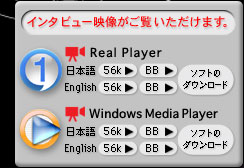  |
 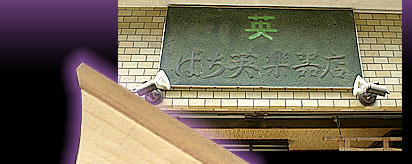 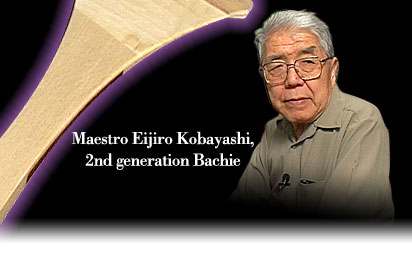 |
 |
Amazake-yokocho street, Ningyo-cho, Nihombashi:
This street, called "Amazake Yokocho", retains the atmosphere of old downtown Edo. It attracts people from the neighboring business areas, tourists, and people making prayers while visiting the Suitengu shrine. In this unique town, there is a "Bachiei" - a Shamisen house which has continued 90 years of tradition since the Taisho period (1917). With sincere and polite work, this bachiei attracts many fans, from professionals such as Kabuki actors and Geisha, to everyday people.Today's guest on "Tokyo Chuo Net" is Maestro Eijiro Kobayashi, a 2nd generation bachiei, together with Mr. Eisuke Kobayashi, the 3rd generation bachiei of the house. |
 |
 |
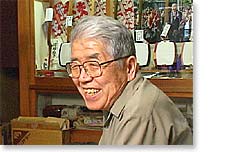 |
| The work: |
 |
| "When we say shamisen house, it sounds like we are only dedicated to the sales of the shamisen. However, that is not the case. As for making the shamisen, since the division of work is established traditionally, we do not finish all the processes at our house but focus on assembling, leathering, repairing, tuning and maintenance of the shamisen instead." |
| Shikomi and Kawabari: |
 |
| "Talking about the shamisen, it is composed of the "Do", or body, and the "Sao", or neck, separately made by different craftspeople. This assembly process is called "Shikomi". The most difficult part in the shikomi is "leathering", to attach leather to the body. Since it's easily affected by weather and climate, it takes the experience and intuition of the craftperson to do this well. It is said to take years for the craftsperson to get to this level. Normally, re-leathering is recommended every 2 to 5 years, not to mention when the leather is torn. By re-leathering from time to time, some of our customers are playing shamisen made during the Meiji era, very carefully." |
| ●Kawabari |
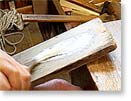 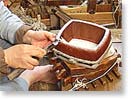 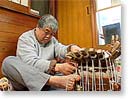
| 1.The special glue made by rice |
|
2.Attach glue to the body |
|
3.lethering |
|
| |
|
 |
 |
| Keeping good traditions |
 |
"Shikomi, or re-leathering, are techniques we acquire using the five senses to the fullest extent. While it is not easy to hand down those techniques, it is very important that the next generation inherits them. Another important factor in making the shamisen is the materials. In recent years, while nylon strings or plastic sticks are seen sometimes, it is always better to play with silk strings and wooden sticks, as they've long been traditionally made. Along with the
materials, using glue made of rice flour in stead of chemicals is one of the tips we inherited from our predecessors." |
|
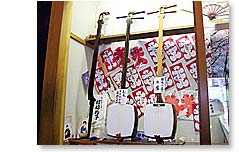 |
|
 |
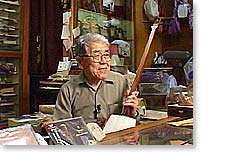 |
| Extended service - Maintenance |
 |
| "Our business philosophy (motto) is to satisfy all of our customers. For beginners, we give them advice, from small tips to introducing shamisen instructors. For experts, we like to maintain their shamisens in the best condition by checking their leather or tune to keep its quality. Maybe it's because the shamisen needs this specialized kind of care that wholesalers do not handle this instrument." |
|
 |
 |
| Shamisen and Kabuki grown together |
 |
"Basically, the shamisen and kabuki were brought up together as one. Since Chuo-ku is the center for Kabuki (the Kabukiza theater is in Ginza, Chuo-ku), we have very strong ties with kabuki. When I was a teenager, I used to study kabuki scripts, such as Mokuami Kawatake -
the play writer, prior to the plays, that's what I remember. Kabuki is very interesting, so more and more people of younger generations and various backgrounds go to see the play at Kabukiza. Of course, that would definitely lead to your deeper understanding of the shamisen."
|
| Strong ties with Nihonbashi |
 |
| Nihonbashi was the business center of the Edo period where plenty of the play houses were located. So, the townspeople of the area were highly aware of the arts and plays, and many women learned how to play shamisen. Also, in "Yoshicho", one of the Hanamachi-geisha districts in the area, many geisha performed shamisen very well as they were skilled in the traditional arts. Shamisen houses grew their business rather naturally over time in this traditional town of Nihonbashi. Ningyocho is filled with the downtown atmosphere of the old Edo period. Since this is a safe and neat neighborhood, please feel free to walk around and stop by at our house. |
|
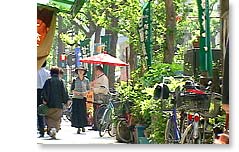 |
 |
|
 |
|
 |